◄ Carnets Geol. 15 (15) ►
Contents
[1. Introduction]
[2. Geological context]
[3. New
localities with Barremian Charophyta]
[4. Systematics (B.G., D.A & S.M.)]
[5. Conclusions]
[Bibliographic references] and ... [Plates]
Dépt.
STU, Fac. Sci. Tech.,
UBO, 6 avenue Le Gorgeu, CS 93837, F-29238 Brest (France)
;
Department of Ecology and Evolutionary Biology, The University of Kansas, 1200 Sunnyside Avenue, Lawrence, Kansas 66045 (USA)
Nanjing Institute of Geology and Palaeontology, Chinese Academy of Sciences, Nanjing 210008 (People's Republic of China);
Lebanese University, Faculty of Science II, Fanar, Natural Sciences Department, Fanar -
El-Matn, P.O. Box 26110217
(Lebanon)
Nanjing Institute of Geology and Palaeontology, Chinese Academy of Sciences, Nanjing 210008 (People's Republic of China);
Lebanese University, Faculty of Science II, Fanar, Natural Sciences Department, Fanar -
El-Matn, P.O. Box 26110217
(Lebanon)
Lebanese University, Faculty of Science II, Fanar, Natural Sciences Department, Fanar - El-Matn, P.O. Box 26110217 (Lebanon)
Lebanese University, Research Platform for Nanosciences and Nanotechnologies, Campus Pierre Gemayel, Fanar, 90656 (Lebanon)
Published online in final form (pdf) on November 11, 2015
[Editor: Michel ;
language editor:
Phil ]
The "Grès du Liban" auct. is the thick basal unit of the Lower Cretaceous series in Lebanon. There are two key levels in this dominantly siliciclastic unit: the "Banc de Mréjatt" and the "Calcaire à pisolithes", the latter of which includes limestones and marls with Charophyta. The rich charophyte assemblage described by and (1968) from a site near Jezzine is Barremian (possibly Early Barremian) in age, not Bedoulian as previously stated. Besides gyrogonites and utricles, charophyte thalli are rather common; they are ascribed to two organ genera, Munieria , 1883, and Charaxis , 1939. Based on topotypic material (from the Collection), Munieria baconica , 1883, the type-species of the genus, is reassessed. In addition, the species Clypeina parvula , 1946, is transferred to the revised genus Munieria, and a new species of Charaxis is described.
Grès du Liban; Barremian; Bedoulian; Aptian; Charophyta; utricles; Munieria; Charaxis.
B., D., S., R. & R. (2015).- New fossiliferous sites with Barremian Charophyta in the "Grès du Liban" auct. (Lebanon), with a critical perspective regarding the nature of Munieria , 1883.- Carnets Geol., Madrid, vol. 15, nº 15, p. 199-229.
Nouveaux gisements fossilifères à Charophytes barrémiens dans les "Grès du Liban" auct. (Liban), avec un point de vue critique sur la nature de Munieria , 1883.- Les "Grès du Liban" auct. constituent l'épaisse unité à la base des séries du Crétacé inférieur au Liban. Il y a deux niveaux-repères dans cette unité essentiellement silicoclastique : le "Banc de Mréjatt" et le "Calcaire à pisolithes" ; ce dernier comporte des passées calcaires ou marneuses à Charophytes. La riche association de Charophytes décrite par et (1968) comme provenant d'un site proche de Jezzine est d'âge barrémien (peut-être Barrémien inférieur) et non bédoulien comme cela était indiqué précédemment. À côté des gyrogonites et des utricules, les thalles de Charophytes sont plutôt communs ; ils sont attribués à deux genres d'organes, Munieria , 1883, et Charaxis , 1939. Sur la base de matériel topotypique (provenant de la Collection ), Munieria baconica , 1883, l'espèce-type du genre, est réexaminée. Pour compléter cette étude, nous transférons l'espèce Clypeina parvula , 1946, dans le genre Munieria révisé et décrivons une nouvelle espèce du genre Charaxis.
Grès du Liban ; Barrémien ; Bédoulien ; Aptien ; Charophytes ; utricules ; Munieria ; Charaxis.
In 1968, and
described new taxa of fossil Charophyta, i.e., one genus and four species, from
"Toumatt-Jezzine, Sud Liban" in the "Grès du Liban, Aptien inférieur" (Bedoulian).
We first attempted to access the site but we could not for security reasons; however, we discovered
three new Lebanese outcrops with similar assemblages and geological settings at
Homsiyeh (near Jezzine), Ain Dara and Falougha (Fig. 1 ![]() ). The new material
collected consists mostly of thalli, gyrogonites and utricles. The vegetative remains
(i.e., the thalli) are of particular interest to us because we identified two organ genera: Munieria , 1883,
and Charaxis , 1939.
But before addressing the systematics let us present the results of our
preliminary geological investigation.
). The new material
collected consists mostly of thalli, gyrogonites and utricles. The vegetative remains
(i.e., the thalli) are of particular interest to us because we identified two organ genera: Munieria , 1883,
and Charaxis , 1939.
But before addressing the systematics let us present the results of our
preliminary geological investigation.
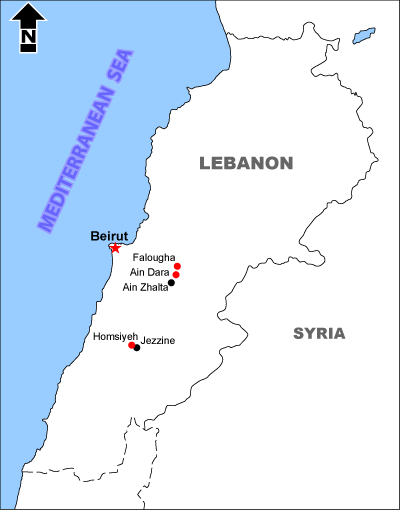
Click on thumbnail to enlarge the image.
Figure 1: Location map of the three new fossiliferous localities (red dots) in Lebanon.
Further to the abandonment of referring to "Muraille de Blanche" and the recent definition of a Jezzinian
regional stage by et al. (2014), there was a need to revise
the underlying Lower Cretaceous unit, i.e., the "Grès du Liban" auct. (Fig. 2 ![]() ).
The lower Jezzinian unconformity (a transgressive surface) falls somewhere
in the "Gastropodenzone von Abeih" of (1878) and its
counterparts (see et al., 2014: Table 1
).
The lower Jezzinian unconformity (a transgressive surface) falls somewhere
in the "Gastropodenzone von Abeih" of (1878) and its
counterparts (see et al., 2014: Table 1 ![]() ), namely:
"Aptien" of (1910),
(1926) and
(1934), "Aptien inférieur" of and
(1937),
"Couches à Gastéropodes" of (1942), C2a of
(1963), … The uppermost part of this
"Gastropodenzone von Abeih" is ascribed to the Jezzinian ( et al., 2014).
), namely:
"Aptien" of (1910),
(1926) and
(1934), "Aptien inférieur" of and
(1937),
"Couches à Gastéropodes" of (1942), C2a of
(1963), … The uppermost part of this
"Gastropodenzone von Abeih" is ascribed to the Jezzinian ( et al., 2014).
The herein amended "Grès du Liban" is equivalent to the lower part of the "Gastropodenzone von Abeih" plus the unit below it, i.e., the "Sandsteinformation des Libanon" of (1878) or its counterparts, namely: "Grès à lignite" of (1910), "Néocomien" of (1910), (1926), (1934) and & (1937), "Grès lignitifères" of (1926) and (1942), "Grès de base" of (1955), C1 of (1955, 1963), …
Regarding the upper boundary of
his "Grès du Liban", (1955) noticed that "Le grès de
base passe insensiblement, vers le haut, à des couches argileuses ou marneuses
avec des bancs très fossillifères. Sa limite supérieure a été tracée
à l'apparition des premières faunes" [The basal sandstone unit gradually
changes upward to argillaceous or marly layers with very fossiliferous beds. Its upper boundary was placed at the first
faunal appearance]. Later, (1963) also added that these
sandstones "ne sont pas partout de même âge" [are not given the same age
across Lebanon]. As for any facies-driven lithostratigraphic unit, we assume
that "This geometrical relationship is merely the signature of regular lateral
changes in facies within a single time-unit" ( et al.,
2014), here in an overall transgressive trend. At Jezzine, the type-locality of
the Jezzinian, et al. (2014) reported the occurrence of
lignite immediately underneath the lower Jezzinian unconformity, another fact
that justifies the merger of the two former lithostratigraphic units (except for
the upper part of the "Gastropodenzone", which belongs to the Jezzinian, see
et al., 2014: Table 1 ![]() ) into the amended "Grès du
Liban".
) into the amended "Grès du
Liban".
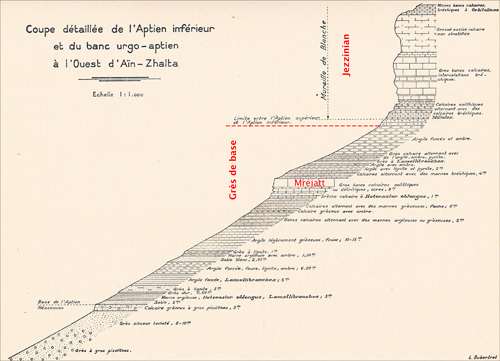
Click on thumbnail to enlarge the image.
Figure 2: Section West of Ain Zhalta, some 5 km SSW of Ain Dara (excerpt from & , 1937: Fig. 28), displaying a typical succession from the "Calcaire à pisolithes" of (1942) to the "Muraille de Blanche" of & (1937). The "Banc de Mréjatt" of (1942) appears here as "Gros bancs calcaires oolithiques ou détritiques, ocres, 8m". In this figure, the strata of "Grès du Liban" auct. are ascribed "Néocomien" and "Aptien inférieur" ages; the "Muraille de Blanche" (i.e., the Jezzinian) is ascribed an "Aptien supérieur" age.
In some Lebanese sections one can identify in the "Grès du Liban" auct.:
The age of the "Grès du Liban" auct. is poorly constrained. The unit above it, i.e., the Jezzinian, spans the latest Barremian - early Bedoulian transition ( et al., 2014) and the limestones below are Late Jurassic in age (, 1963), though we cannot completely exclude an earliest Cretaceous age for their higher beds.
In the upper part of the "Grès du Liban" auct., there are few age-diagnostic macro- or micro- fossils:
To summarize, whereas the "Grès du Liban" auct. are Barremian and possibly older in age, the charophyte strata therein could be restricted to the Barremian (possibly to the Early Barremian only).
When and
(1968) described their new fossil charophyte taxa from the Lower Cretaceous of Lebanon, they
mentioned that the original
material came from a section studied by (1965,
1972). According to
them, it was located "5 km Sud-Est de Jezzine". However, when we checked 's
unpublished thesis (1965) looking for the precise location of the site, we
found that it is actually on the side of an abandoned mountain road some 3 km
only ESE of Jezzine (South Lebanon Governorate) in Mount Lebanon Governorate (Fig.
3 ![]() , blue
dot). Unfortunately, this strategic passage to the Bekaa valley still requires
clearing from land mines. Fortunately, we discovered nearby a new outcrop in a
similar setting, at Homsiyeh, 2.5 km WNW of Jezzine (Fig.
3
, blue
dot). Unfortunately, this strategic passage to the Bekaa valley still requires
clearing from land mines. Fortunately, we discovered nearby a new outcrop in a
similar setting, at Homsiyeh, 2.5 km WNW of Jezzine (Fig.
3 ![]() , red dot; N 33°32'49.173",
E 35°33'46.154", alt. 1081m); later we also identified two new localities
some 30 km ESE of Beirut (and 30 km NNW of Jezzine), both in Mount Lebanon
Governorate: 1.5 km N of Ain Dara (N 33°47'41.197", E 35°43'37.122",
alt. 1272m) and 1 km E of Falougha (N 33°50'4.374", E 35°45'14.739",
alt. 1530m).
, red dot; N 33°32'49.173",
E 35°33'46.154", alt. 1081m); later we also identified two new localities
some 30 km ESE of Beirut (and 30 km NNW of Jezzine), both in Mount Lebanon
Governorate: 1.5 km N of Ain Dara (N 33°47'41.197", E 35°43'37.122",
alt. 1272m) and 1 km E of Falougha (N 33°50'4.374", E 35°45'14.739",
alt. 1530m).
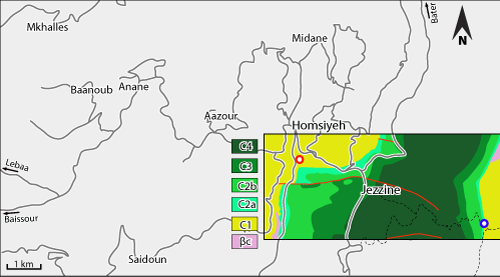
Click on thumbnail to enlarge the image.
Figure 3: Location map of 's site, ESE of Jezzine (blue dot), and of the new site at Homsiyeh, WNW of Jezzine (red dot). Geological map of (1950): ßc Cretaceous basalt; C1, "Grès de base"; C2a, "Aptien inférieur"; C2b, "Aptien supérieur"; C3, "Albien"; C4, "Cénomanien".
At Homsiyeh (Fig.
3 ![]() , red
dot), within the
pisolitic marls, we identified a 3 m thick interval consisting of limestones
with mudstone and wackestone textures (Fig. 4
, red
dot), within the
pisolitic marls, we identified a 3 m thick interval consisting of limestones
with mudstone and wackestone textures (Fig. 4 ![]() ). The lower 1.5 m part, which is
extensively bioturbated with large burrows up to 7 cm in diameter,
corresponds to marine deposits. The upper 1.5 m part corresponds to deposits in
brackish coastal swamps. Isolated charophyte remains (thalli, utricles and
gyrogonites) were obtained after washing and sieving the sediment from the marly
layers and thin sections were made from the limestones. Some sections of utricles observed in the limestone
are shown in our Pl.
2
). The lower 1.5 m part, which is
extensively bioturbated with large burrows up to 7 cm in diameter,
corresponds to marine deposits. The upper 1.5 m part corresponds to deposits in
brackish coastal swamps. Isolated charophyte remains (thalli, utricles and
gyrogonites) were obtained after washing and sieving the sediment from the marly
layers and thin sections were made from the limestones. Some sections of utricles observed in the limestone
are shown in our Pl.
2 ![]() :
figs. A-G. and
(1983: Pl. IV, fig. 2; Pl. XIII, fig. 4) have described as "Chara gyrogonits"
some Hungarian specimens
similar to our material; specifically, sections of utricles
with the characteristic 6 pores corresponding to the 6 spine-shaped bracts of
the external utricular layer as documented in our material (Pl.
2
:
figs. A-G. and
(1983: Pl. IV, fig. 2; Pl. XIII, fig. 4) have described as "Chara gyrogonits"
some Hungarian specimens
similar to our material; specifically, sections of utricles
with the characteristic 6 pores corresponding to the 6 spine-shaped bracts of
the external utricular layer as documented in our material (Pl.
2 ![]() , fig. A-G).
We also illustrate some
sections of small-sized Muniera-like thalli (Pl.
2
, fig. A-G).
We also illustrate some
sections of small-sized Muniera-like thalli (Pl.
2 ![]() , figs. H-K): Munieria
parvula ,
1946, n.comb. (see § Systematics). In
addition, in the marly levels, we identified Clavator ampullaceus (
& , 1968) ,
1996 (Pl. 3
, figs. H-K): Munieria
parvula ,
1946, n.comb. (see § Systematics). In
addition, in the marly levels, we identified Clavator ampullaceus (
& , 1968) ,
1996 (Pl. 3 ![]() , figs. A-E), Clavator
delteus ( & , 1968) n.comb. , & [*]
(Pl. 3
, figs. A-E), Clavator
delteus ( & , 1968) n.comb. , & [*]
(Pl. 3 ![]() , figs. F-H), Ascidiella reticulata & , 1968
(Pl. 3
, figs. F-H), Ascidiella reticulata & , 1968
(Pl. 3 ![]() , figs. I-K), and the Triploporellacean
alga Salpingoporella (Hensonella) dinarica (,
1959) (Pl. 4
, figs. I-K), and the Triploporellacean
alga Salpingoporella (Hensonella) dinarica (,
1959) (Pl. 4 ![]() , figs. H-I).
, figs. H-I).
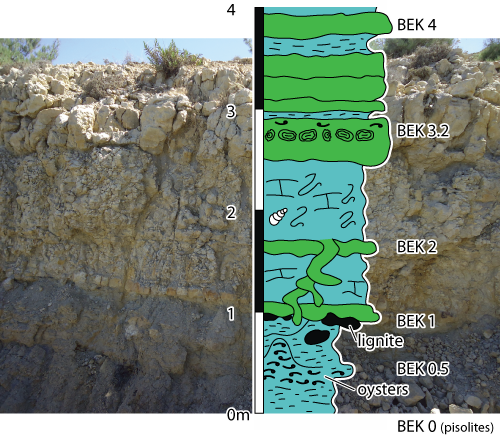
Click on thumbnail to enlarge the image.
Figure 4: Detail of the section at Homsiyeh. BEK 0.5 is a floatstone of bored oysters with a bioclastic wackestone matrix. Choffatella gr. decipiens are abundant and sand-sized quartz grains are common. BEK 1 is a bioclastic wackestone with gastropods, Choffatella gr. decipiens and Salpingoporella dinarica. BEK 2 is a bioturbated mudstone with silt-sized quartz grains. BEK 3.2 is a floatstone of pisolites with a bioclastic wackestone matrix. Bioclasts consist of Salpingoporella dinarica, gyrogonites and Charophyta thalli (Munieria parvula n.comb.). BEK 4 is a bioclastic wackestone with abundant Charophyta remains (thalli, utricles and gyrogonites).
At Ain Dara (Fig. 1 ![]() ;
Pl. 1
;
Pl. 1 ![]() ,
fig. B), we sampled marls above and below a thick bed consisting of lacustrine
limestones, located some ten meters below the "Banc de Mréjatt". In the marly
levels, we identified Clavator ampullaceus ( & ,
1968) (Pl. 4
,
fig. B), we sampled marls above and below a thick bed consisting of lacustrine
limestones, located some ten meters below the "Banc de Mréjatt". In the marly
levels, we identified Clavator ampullaceus ( & ,
1968) (Pl. 4 ![]() , figs. A-F), Atopochara
trivolvis var. triquetra
, 1968 (Pl. 5
, figs. A-F), Atopochara
trivolvis var. triquetra
, 1968 (Pl. 5 ![]() , fig. D) and a new representative of the organ genus Charaxis , 1939
(Pl. 4
, fig. D) and a new representative of the organ genus Charaxis , 1939
(Pl. 4 ![]() , fig. G;
Pl. 5
, fig. G;
Pl. 5 ![]() , figs. E-I;
Pl. 6
, figs. E-I;
Pl. 6 ![]() , figs.
A-E). The limestone bed (Pl. 6
, figs.
A-E). The limestone bed (Pl. 6 ![]() , fig. F)
also contains an abundance of these Charaxis-like
thalli (see § Systematics)
, fig. F)
also contains an abundance of these Charaxis-like
thalli (see § Systematics)
At Falougha (Fig. 1 ![]() ;
Pl. 1
;
Pl. 1 ![]() ,
fig. A), we sampled marls within a set of beds consisting of lacustrine
limestones, located a few meters below the "Banc de Mréjatt". In this marly
level, we identified Sphaerochara
asema (
& , 1968) n.comb. , & [*] (Pl. 5
,
fig. A), we sampled marls within a set of beds consisting of lacustrine
limestones, located a few meters below the "Banc de Mréjatt". In this marly
level, we identified Sphaerochara
asema (
& , 1968) n.comb. , & [*] (Pl. 5 ![]() , fig. A) and Ascidiella
reticulata
& , 1968 (Pl. 5
, fig. A) and Ascidiella
reticulata
& , 1968 (Pl. 5 ![]() , figs. B-C).
, figs. B-C).
Article 11.1 of the "International Code of Nomenclature for algae, fungi, and plants" ( et al., 2012) states that "the use of separate names is allowed for fossil-taxa that represent different parts, life-history stages, or preservational states of what may have been a single organismal taxon or even a single individual (Art. 1.2)". This section on systematics deals with charophyte thalli ascribed to the organ genera Munieria , 1883, and Charaxis , 1939.
Division Charophyta , 1897
Class Charophyceae , 1838
Order Charales , 1836
Organ genus Munieria , 1883
Almost 40 years passed between the description of Munieria baconica by (1883) and new illustrations of this species by (1920); again another 40 years passed until new Munieria specimens were illustrated by and (1962). During this 1920-1960 period, new species were introduced; however, they were not ascribed to this genus but either to the Polyphysacean genus Clypeina (, 1845) or the charophyte genus Charaxis , 1939. During this period, all the identifications of the species baconica were erroneous because the illustrated specimens were mainly representatives of the Polyphysacean genera Clypeina or Actinoporella in , 1882. In addition, although the specimens of and (1962) belong to Munieria, they should not be ascribed to the species M. baconica mainly due to differences in sizes. To complete this story, we note that a new species was introduced by (1976) and a new variety by et al. (1981).
The question of the ascription of the genus Munieria to the Dasycladales (, 1920; , 1969; et al., 2003, 2005) or to the Charophytes (, 1969; et al., 1978; & , 1983; , 1989; & , 1993; , 2000) was until now still in debate, despite the fact that all the elements necessary to establish that all Munieria species should be referred to as Charophytes (i.e., random and oriented sections, isolated specimens, 3D reconstructions, mineralogy [*], micropaleontological assemblages and paleoenvironments) were already present in 's paper (1969) and supported by the excellent illustrations of (1972).
There
is no original diagnosis for this monotypic genus. We cite the
original description of its subordinate species (, 1883, p. 9-11):
"Das Fossil (Fig. 4 ![]() ) ist
5-7 mm lang, rund cylindrisch, oben rasch in eine stumpfe Spitze auslaufend. Es besteht aus einer Anzahl von gleichwerthigen, gleichgebauten, biconcaven
Gliedern, deren immer 2 auf den Millimeter gehen, so dass man bei der Länge von
5-7 mm deren 10-14 zählen kann. Der Querschnitt in der Mitte der Kalkalge beträgt
0,75 mm und nimmt nach oben und unten nur ganz wenig ab, respektive zu. Aussen
ist auf der Mitte eines jeden Gliedes ein einfacher Kranz von runden grossen
Poren zu sehen, der meist ein klein wenig über dem übrigen Theile des Gliedes
erhaben ist, was man wohl der Verwitterung zuschreiben darf. Sonst zeigte sich
keine weitere Ornamentirung, und an gut erhaltenen Exemplaren reihen sich die
Glieder ununterbrochen an einander, so dass selbst ihre Grenzlinien verschwimmen
und ihre Zahl nur aus der Anzahl der Porenkränze geschlossen werden kann.
Solche Individuen sind jedoch recht selten, meistens zeigen sich die Pflanzen
gliederweise verschoben, so dass die einzelnen Glieder stufenweise auf und neben
einander liegen."
) ist
5-7 mm lang, rund cylindrisch, oben rasch in eine stumpfe Spitze auslaufend. Es besteht aus einer Anzahl von gleichwerthigen, gleichgebauten, biconcaven
Gliedern, deren immer 2 auf den Millimeter gehen, so dass man bei der Länge von
5-7 mm deren 10-14 zählen kann. Der Querschnitt in der Mitte der Kalkalge beträgt
0,75 mm und nimmt nach oben und unten nur ganz wenig ab, respektive zu. Aussen
ist auf der Mitte eines jeden Gliedes ein einfacher Kranz von runden grossen
Poren zu sehen, der meist ein klein wenig über dem übrigen Theile des Gliedes
erhaben ist, was man wohl der Verwitterung zuschreiben darf. Sonst zeigte sich
keine weitere Ornamentirung, und an gut erhaltenen Exemplaren reihen sich die
Glieder ununterbrochen an einander, so dass selbst ihre Grenzlinien verschwimmen
und ihre Zahl nur aus der Anzahl der Porenkränze geschlossen werden kann.
Solche Individuen sind jedoch recht selten, meistens zeigen sich die Pflanzen
gliederweise verschoben, so dass die einzelnen Glieder stufenweise auf und neben
einander liegen."
[The fossil (Pl. I, fig. 4 ![]() ) is 5 to 7 mm long, roughly cylindrical, and ends abruptly in a blunt tip. It has a number of equal, similar, biconcave segments; there are always two per millimeter, that is, there are from 10 to 14 of them on the 5 to 7 mm long specimens. The diameter of this calcareous alga is 0.75 mm in the middle and tapers slightly in both directions. A single ray of large round pores surrounds the middle of each segment. The ray is slightly raised above the other parts of the segment perhaps due to weathering. There are no further ornaments and in well-preserved samples the segments are strung together without interruption so that even the boundaries are blurred. Therefore their number can be assessed only by the number of the rings of pores. However, such intact specimens are very rare because the individual segments separate and end up either next to each other or overlapped.]
) is 5 to 7 mm long, roughly cylindrical, and ends abruptly in a blunt tip. It has a number of equal, similar, biconcave segments; there are always two per millimeter, that is, there are from 10 to 14 of them on the 5 to 7 mm long specimens. The diameter of this calcareous alga is 0.75 mm in the middle and tapers slightly in both directions. A single ray of large round pores surrounds the middle of each segment. The ray is slightly raised above the other parts of the segment perhaps due to weathering. There are no further ornaments and in well-preserved samples the segments are strung together without interruption so that even the boundaries are blurred. Therefore their number can be assessed only by the number of the rings of pores. However, such intact specimens are very rare because the individual segments separate and end up either next to each other or overlapped.]
"Ein
Querschnitt (Fig. 5 ![]() ), in der Ebene des Porenringes geführt, zeigt uns in der
Mitte eines jeden Gliedes einen runden ziemlich weiten Axenkanal, von dem radial
12-16 grosse, einfache Seitenkanäle ausstrahlen. Dieselben beginnen fein,
erweitern sich dann mehr und mehr, bis sie sich dicht vor der Mündung wieder
einschnüren. Dadurch erhalten sie eine keulenförmige Gestalt, an der sie in
den Dünnschliffen leicht zu erkennen sind. Diese Porenkanäle liegen
eingebettet in eine Kalkschicht (Fig. 5
), in der Ebene des Porenringes geführt, zeigt uns in der
Mitte eines jeden Gliedes einen runden ziemlich weiten Axenkanal, von dem radial
12-16 grosse, einfache Seitenkanäle ausstrahlen. Dieselben beginnen fein,
erweitern sich dann mehr und mehr, bis sie sich dicht vor der Mündung wieder
einschnüren. Dadurch erhalten sie eine keulenförmige Gestalt, an der sie in
den Dünnschliffen leicht zu erkennen sind. Diese Porenkanäle liegen
eingebettet in eine Kalkschicht (Fig. 5 ![]() , k), welche den ringförmig
cylindrischen Raum, der in jedem Gliede von dem Axenkanale und der Aussenwand
umschlossen wird, in der Mitte horizontal durchsetzt und denselben in zwei
getrennte Hälften zerlegt, die mit einander nur durch den Centralkanal
kommuniziren. Ein Längsschnitt (Fig. 6
, k), welche den ringförmig
cylindrischen Raum, der in jedem Gliede von dem Axenkanale und der Aussenwand
umschlossen wird, in der Mitte horizontal durchsetzt und denselben in zwei
getrennte Hälften zerlegt, die mit einander nur durch den Centralkanal
kommuniziren. Ein Längsschnitt (Fig. 6 ![]() ) durch die Mitte des Axenkanales gelegt,
zeigt uns, wie sich die äussere Wandung der Glieder von dem Porenkranze aus
noch ein gutes Stück nach oben und unten erstreckt und sich dabei derart verdünnt,
dass sie an der Berührungsfläche mit dem nächsten Gliede ihre geringste Dicke
erlangt. Es erhalten hierdurch die Glieder eine eigenthümlich biconcave Form,
welche für den Gesammtaufbau der Pflanze äusserst charakteristisch ist. Denn
weil sich zwei solche Glieder nur an der Aussenwand in einem sehr schmalen Ringe
und dann nur noch in dem Centralkanal berühren. so muss bei ihrer biconcaven
Gestalt dadurch ein ringförmiger Hohlraum entstehen, der zwischen dem Kanal und
der Wand herumläuft. Es scheint derselbe von der Aussenwelt und dem centralen
Rohre abgeschlossen gewesen zu sein, wenigstens habe ich trotz langen Suchens
keine Poren mehr finden können, die ihm mit dem einen oder der anderen eine
Communikation erlaubt hätten. Als wahrscheinlicher muss aber doch angenommen
werden, dass dieser Hohlraum mit Algenmasse erfüllt war, die sich von dem
centralen Algenfaden aus durch die Intermittenz des centralen Kanales an der Berührungsstelle
zweier Glieder in diese Zwischenräume hin erstrecke."
) durch die Mitte des Axenkanales gelegt,
zeigt uns, wie sich die äussere Wandung der Glieder von dem Porenkranze aus
noch ein gutes Stück nach oben und unten erstreckt und sich dabei derart verdünnt,
dass sie an der Berührungsfläche mit dem nächsten Gliede ihre geringste Dicke
erlangt. Es erhalten hierdurch die Glieder eine eigenthümlich biconcave Form,
welche für den Gesammtaufbau der Pflanze äusserst charakteristisch ist. Denn
weil sich zwei solche Glieder nur an der Aussenwand in einem sehr schmalen Ringe
und dann nur noch in dem Centralkanal berühren. so muss bei ihrer biconcaven
Gestalt dadurch ein ringförmiger Hohlraum entstehen, der zwischen dem Kanal und
der Wand herumläuft. Es scheint derselbe von der Aussenwelt und dem centralen
Rohre abgeschlossen gewesen zu sein, wenigstens habe ich trotz langen Suchens
keine Poren mehr finden können, die ihm mit dem einen oder der anderen eine
Communikation erlaubt hätten. Als wahrscheinlicher muss aber doch angenommen
werden, dass dieser Hohlraum mit Algenmasse erfüllt war, die sich von dem
centralen Algenfaden aus durch die Intermittenz des centralen Kanales an der Berührungsstelle
zweier Glieder in diese Zwischenräume hin erstrecke."
[A cross-section (Pl. I, fig. 5 ![]() ) through the level of the ring of pores reveals a round, wide axial channel in the middle of each segment from which 12 - 16 large simple side channels radiate. These side channels are at first thin and then gradually become wider until they become restricted near the end. The resultant club-shape is readily identified in thin sections. The pore channels are embedded in a calcareous layer (Pl. I, fig. 5
) through the level of the ring of pores reveals a round, wide axial channel in the middle of each segment from which 12 - 16 large simple side channels radiate. These side channels are at first thin and then gradually become wider until they become restricted near the end. The resultant club-shape is readily identified in thin sections. The pore channels are embedded in a calcareous layer (Pl. I, fig. 5 ![]() , k) that accumulates in the middle at right angles to the circular, cylindrical space formed by the axial channel and outer wall of each segment. The space is separated into two halves which communicate with each other through the central channel. A longitudinal section (Pl. I, fig. 6
, k) that accumulates in the middle at right angles to the circular, cylindrical space formed by the axial channel and outer wall of each segment. The space is separated into two halves which communicate with each other through the central channel. A longitudinal section (Pl. I, fig. 6 ![]() ) through the middle of the axial channel demonstrates that the outer wall of the segments extends considerably above and below the pore ring and becomes narrower in such a way that it has its smallest diameter at the contact surface with the next segment. Therefore the segments have a curious biconcave shape which is highly characteristic of the basic construction of the plant. If two such segments only touch each other on the outer wall in a small ring and in the central channel, the biconcave shape should lead to a ring-shaped cavity between channel and wall. This cavity seems to have been separated from the outside and the central pipe. In spite of intense search, I did not observe additional pores which would allow communication between one cavity and the other. It is possible that this cavity was filled with an algal mass which extended from the central alga thread through the central channel where two segments meet.]
) through the middle of the axial channel demonstrates that the outer wall of the segments extends considerably above and below the pore ring and becomes narrower in such a way that it has its smallest diameter at the contact surface with the next segment. Therefore the segments have a curious biconcave shape which is highly characteristic of the basic construction of the plant. If two such segments only touch each other on the outer wall in a small ring and in the central channel, the biconcave shape should lead to a ring-shaped cavity between channel and wall. This cavity seems to have been separated from the outside and the central pipe. In spite of intense search, I did not observe additional pores which would allow communication between one cavity and the other. It is possible that this cavity was filled with an algal mass which extended from the central alga thread through the central channel where two segments meet.]
"Wie weiter der Längsschnitt lehrt, erweitert sich der Axenkanal an den Punkten, wo er die Verticillen entsendet, ein wenig und endigt oben in einem kleinen knopfartigen Vegetationspunkte."
[The longitudinal section also shows that the axial channel extends from the point of the origins of the whorls and terminates at the top in a small button-shaped point.]
"Ein
derartiges leichtes, mit grossen Hohlräumen versehenes Kalkgerüst, muss natürlich
rasch in seine Bestandtheile zerfallen, sobald dieselben nicht mehr von der
Pflanzenmasse zusammengehalten werden. Als solche Trennungsstellen sind ja an
und für sich schon die Berührungsflächen der Glieder charakterisirt; hier bei
Munieria jedoch sind es dieselben in noch höherem Grade, weil sich an
diesen Punkten sowohl die dünnste Stelle befindet als auch hinter derselben
noch der grosse Hohlraum liegt. Bei schwachem seitlichen Drucke musste daher
schon das Gerüst hier zerbrechen, und so erklärt sich die Seltenheit der
unverletzten und das Vorwiegen der gliederweis zerbrochenen Exemplare. Auch
solche einzelne Glieder hat H. M. v. angetroffen; dann zeigen
dieselben aber noch einen viel weiter vorgeschrittenen Zustand der Zerstörung,
derart, dass nach Abwitterung alles anderen eigentlich nur die mittlere Partie
erhalten geblieben und ein solches Glied auf die Hälfte seiner ursprünglichen
Höhe reducirt ist. Ich habe eines von ihnen in Fig. 7 ![]() wiedergegeben, da uns
dasselbe die Beschaffenheit der Oberfläche der Munieria-Glieder
ausgezeichnet erkennen lässt. Auf der Kalkschicht, welche, wie ich oben sagte,
die Poren umschliesst, zeigen sich denselben ganz entsprechende Erhöhungen, die
fein von dem Centralkanale ausstrahlend sich nach dem Rande zu keulenartig
verdicken, ebenso wie ich es oben von einer einzelnen Verticille beschrieben
habe. Man sieht aus der Zeichnung schon, dass die ganze Kalkschicht nichts
anders als das Produkt der sich berührenden Verticillen ist."
wiedergegeben, da uns
dasselbe die Beschaffenheit der Oberfläche der Munieria-Glieder
ausgezeichnet erkennen lässt. Auf der Kalkschicht, welche, wie ich oben sagte,
die Poren umschliesst, zeigen sich denselben ganz entsprechende Erhöhungen, die
fein von dem Centralkanale ausstrahlend sich nach dem Rande zu keulenartig
verdicken, ebenso wie ich es oben von einer einzelnen Verticille beschrieben
habe. Man sieht aus der Zeichnung schon, dass die ganze Kalkschicht nichts
anders als das Produkt der sich berührenden Verticillen ist."
[Clearly such a delicate calcareous structure with large cavities disintegrates rapidly into its elements if it is not kept together anymore by the mass of the plant. Characteristically, such parts separate at the contact surfaces of the segments; however, for Munieria this holds true even more since it is thinnest at these surfaces which are also in front of large cavities. The skeleton would already disintegrate with a slight lateral pressure. Therefore, intact skeletons are rare but there are numerous segments of broken specimens. Such single segments were observed by H. M. v. . However, these reveal an advanced state of deterioration so that with the continuing weathering of their entirety only the middle part is preserved and is reduced to half of its initial height. I show one of them in Pl. I, fig. 7 ![]() because it demonstrates very well the composition of the surface of the Munieria segments. As I mentioned above, the same elevations around the pores can be seen on the calcareous layer which surrounds them. They radiate from the central channel, where they are thin, to the rim, becoming club shaped on the way, just as I described above for the single whorls. One can see in the drawing that the whole calcareous layer is only the result of the whorls touching each other.]
because it demonstrates very well the composition of the surface of the Munieria segments. As I mentioned above, the same elevations around the pores can be seen on the calcareous layer which surrounds them. They radiate from the central channel, where they are thin, to the rim, becoming club shaped on the way, just as I described above for the single whorls. One can see in the drawing that the whole calcareous layer is only the result of the whorls touching each other.]
"Wenn wir
uns jetzt nach dem wirklich Beobachteten die Pflanze selbst wieder herzustellen
suchen, so erhalten wir folgendes Bild. Der centrale Algenfaden Fig. 8 ![]() )
erstreckt sich von der Wurzel bis in die Spitze, wo er in dem knopfartigen
Vegetationspunkte endigte. Er schied den Kalk des Axenkanales ab. Von Zeit zu
Zeit erweiterte sich aber derselbe und entsandte dann 12-16 Verticillzweige (v),
die gleichfalls mit der Eigenschaft sich zu inkrustiren ausgestattet waren und
sich daber in ihrer ganzen Länge mit Kalk umgaben. Und so entstand die
Kalkschicht (w) in der Mitte der Glieder."
)
erstreckt sich von der Wurzel bis in die Spitze, wo er in dem knopfartigen
Vegetationspunkte endigte. Er schied den Kalk des Axenkanales ab. Von Zeit zu
Zeit erweiterte sich aber derselbe und entsandte dann 12-16 Verticillzweige (v),
die gleichfalls mit der Eigenschaft sich zu inkrustiren ausgestattet waren und
sich daber in ihrer ganzen Länge mit Kalk umgaben. Und so entstand die
Kalkschicht (w) in der Mitte der Glieder."
[If we try to reconstruct the plant from the real observations we can make the following picture. The central alga thread (Pl. I, fig. 8 ![]() ) extends from the root to the tip where it terminates in a button-shaped point. The thread secreted the calcium of the axial channel. From time to time however, it
widened and developed 12 - 16 branches of verticilles (v) (whorls), which also
calcified and, therefore, in their whole length were surrounded by calcium. This is how the calcareous layer (w) in the middle of the segments arose.]
) extends from the root to the tip where it terminates in a button-shaped point. The thread secreted the calcium of the axial channel. From time to time however, it
widened and developed 12 - 16 branches of verticilles (v) (whorls), which also
calcified and, therefore, in their whole length were surrounded by calcium. This is how the calcareous layer (w) in the middle of the segments arose.]
Emended generic diagnosis (B.G.): "Remains of Charophyte thalli consisting of the intercellular calcification of nodes and internodes, commonly broken at the level of the nodes in individual 'articles' (internodes) or short series of 'articles' (internodes plus nodes). At the level of a node, pores are arranged in a single whorl; they correspond to rather long nodal cells from each of which departs a set of cortical cells. The internodes are preserved in the form of hollow calcitic cylinders with the axial hole corresponding to one internodal cell and often displaying a ribbed outer surface where the grooves correspond to the mark of the contiguous cortical cells. The inner diameter of an internode is commonly less than half its outer diameter."
Type-species: Munieria baconica , 1883.
Munieria baconica , 1883
(Pl. 7 ![]() , figs. A-G;
Pl. 8
, figs. A-G;
Pl. 8 ![]() ,
figs. A-F)
,
figs. A-F)
Synonymy list (years in red color indicate papers with original, previously unpublished illustrations):
1883 Munieria baconica M. von .- , p. 9-11, Pl. 1, figs. 4, 4a, 5-6 [Aptian fide & , 1972], 7-8 (reconstruction)
non 1883 Munieria baconica ("Fructifikationsorgane").- , Pl. 1, fig. 9 {Charaxis sp.}
? 1883 Munieria baconica ("Fructifikationsorgane").- , Pl. 1, fig. 10
1913 Munieria baconica.- , p. 240-242, Figs. 3-4 (excerpt from , 1883)
1920 Munieria baconica.- , p. 144-146, Fig. 25, 7-8 (reconstruction); Pl. VII, figs. 16-26 [Aptian fide & , 1972]
1927 Munieria baconica.- in , p. 70-71, Fig. 51 (excerpt from , 1920)
non 1948 Munieria baconica.- , p. 147-149, Fig. 48(1-17); Pl. VI, fig. 3 {Actinoporella podolica () fide et al. (1974), pro parte, and Clypeina ? solkani & fide & (1972), pro parte}
non 1955 Munieria baconica.- , p. 47-49, Figs. 10(1-20)-11(1-17)-12(1-20); Pl. VI, fig. 2 {Actinoporella podolica () fide et al. (1974), pro parte, and Clypeina ? solkani & fide & (1972), pro parte}
non 1958 Munieria baconica.- , p. 190-191, Fig. 27 {Clypeina ? solkani & fide & (1972)}
non 1958a Munieria baconica.- , 255, Pl. 45, fig. 1 {Actinoporella podolica () fide et al. (1974)}
non 1958b Munieria baconica.- , Pl. 3, fig. 1 {Clypeina sp. fide (1968)}
non 1958 Munieria baconica.- , Pl. 3, fig. 1 {Actinoporella podolica () fide et al. (1974)}
non 1958 Munieria baconica.- , p. 83, Figs. 2-3; Pl. I, figs. 1-3 {Clypeina ? solkani & fide & (1972)}
non 1960 Munieria baconica.- , Pl. VIII, fig. 2; Pl. IX, fig. 2 {Clypeina ? solkani & fide & (1972)}
1961 Munieria baconica.- (French version by ), p. 144-146, Fig. 25; Pl. 7, figs. 16-26
1961 Munieria baconica.- , p. 131, Pl. 56, figs. 1-7 (excerpts from , 1920)
non 1962 Munieria baconica.- & , Pl. XXXII, figs. 5-6 & 9
non 1968 Munieria baconica.- , p. 57-58, Pl. 15, figs. 3-8 {Clypeina ? solkani & fide & (1972)}
1969 Munieria baconica.- , p. 67, Pl. 48, figs. 1-12 (excerpts from , 1920)
1969 Munieria sp. 1.- , p. 235, Pl. 2, figs. 10-14 [Santonian]
1969 Munieria sp. 2.- , p. 235, Pl. 2, figs. 15-17 [Santonian]
non 1970 Munieria baconica.- , Pl. 2, figs. 6-7
non 1971 Munieria baconica.- & , p. 422, Pl. 3, figs. 3-4
1972 Munieria baconica.- & , p. 88-89, Fig. 4; Pl. I, figs. 1-3 [Aptian]
non 1972 Munieria baconica.- , p. 380 & 383, Fig. 4(k-l)
1976 Munieria baconica.- , p. 54-60, Pl. III, figs. 1-8; Pl. IV, figs. 1, 3-7 [Aptian]
non 1978 Munieria baconica.- , Pl. XXVII, fig. 14 {Clavatoraxis sp.}
non 1979 Munieria baconica.- & , p. 54-60, Pl. I, fig. 1 {Montiella sp.}
1983 Munieria baconica.- & , p. 171, Pl. I, figs. 1-3; Pl. II, figs. 1-3; Pl. IV, figs. 1-2; Pl. V, fig. 3; Pl. XII, figs. 1-4
1983 Munieria sp. A.- & , Pl. IX, figs. 1-2; Pl. X, figs. 1-2
non 1987 Munieria baconica.- , p. 173, Pl. 30, figs. g-h {cf. Clypeina parasolkani & }
non 1988 Munieria baconien [sic].- , p. 59-60, Pl. 1, figs. g-h (excerpt from , 1987)
2003 Munieria baconica.- et al., p. 128-129, Figs. 8-15 [Aptian]
2013 Munieria baconica.- & , p. 156, Fig. p. 158(5) [Tés Marl Fm = Albian]
(1883) drew an
isolated specimen (op. cit.: Pl. 1, figs. 4 & 4a; herein Figs.
5.4 & 5.4a ![]() ) and few sections and reconstructions of Munieria baconica,
the type-species of the genus. One of his drawings (op. cit.: Pl.
1, fig. 9; herein Fig. 5.9
) and few sections and reconstructions of Munieria baconica,
the type-species of the genus. One of his drawings (op. cit.: Pl.
1, fig. 9; herein Fig. 5.9 ![]() ) labelled "Fructifikationsorgane" probably
represents a section of another charophyte thallus, a Charaxis sp. The more
representative drawings are his Pl. 1, fig. 5 (herein Fig. 5.5
) labelled "Fructifikationsorgane" probably
represents a section of another charophyte thallus, a Charaxis sp. The more
representative drawings are his Pl. 1, fig. 5 (herein Fig. 5.5 ![]() ), which is a transverse section at the
level of an internode (see our Pl. 7
), which is a transverse section at the
level of an internode (see our Pl. 7 ![]() , fig. F), and his Pl. 1, fig.
6 (herein Fig. 5.6
, fig. F), and his Pl. 1, fig.
6 (herein Fig. 5.6 ![]() ), which is
an axial section (see our Pl. 8
), which is
an axial section (see our Pl. 8 ![]() , fig. F). This original
material is possibly lost.
, fig. F). This original
material is possibly lost.
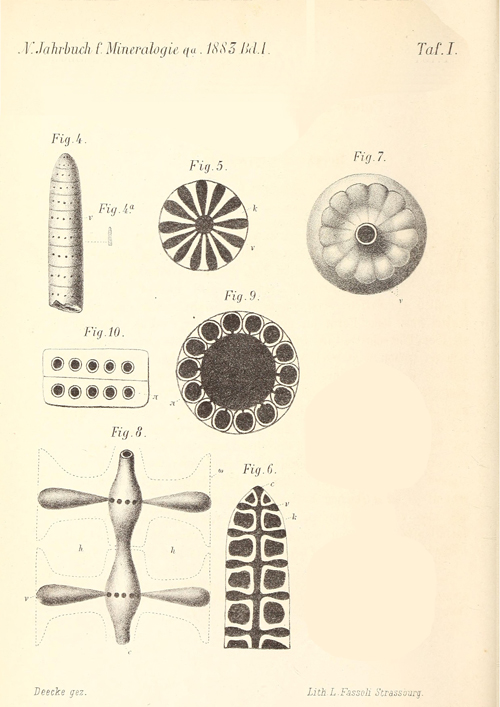
Click on thumbnail to enlarge the image.
Figure 5: Excerpt from (1883).
However, the species is better known from 's 1920 book
on "Die Siphoneae verticillatae vom Karbon bis zur Kreide" (or its 1961
French version as "Les Siphonées verticillées du Carbonifère au Crétacé").
The thin sections studied by in 1920 are part of the collection hosted
by the Naturhistorisches Museum Wien, but they were not inventoried because they
were part of a small set of thin sections that were not given a label [*]. One of us (B.G.) identified the
material studied by (1920: Pl. VII, figs. 16-26; herein under
Pl. 7 ![]() , figs. A-E & G and
Pl. 8
, figs. A-E & G and
Pl. 8 ![]() , figs. A-E):
eight (8) drawings that illustrate specimens from thin section M.F.I. 70 (Fig. 6
, figs. A-E):
eight (8) drawings that illustrate specimens from thin section M.F.I. 70 (Fig. 6 ![]() ), from a
rock sample collected at Pénzesgyőr (Hungary) and sent to
either by M. (the collector of the material originally studied by ), L. or H.V. ; two (2)
drawings from thin section M.F.I. 73 (Fig. 6
), from a
rock sample collected at Pénzesgyőr (Hungary) and sent to
either by M. (the collector of the material originally studied by ), L. or H.V. ; two (2)
drawings from thin section M.F.I. 73 (Fig. 6 ![]() ), Sűrű-hegy (Hungary),
and one (1)
drawing from thin
section M.F.I. 72 (Fig. 6
), Sűrű-hegy (Hungary),
and one (1)
drawing from thin
section M.F.I. 72 (Fig. 6 ![]() ), Tündérmajor (Hungary). All these localities are situated
within a 5 kilometre radius from Zirc in the Veszprém county (Hungary).
), Tündérmajor (Hungary). All these localities are situated
within a 5 kilometre radius from Zirc in the Veszprém county (Hungary).
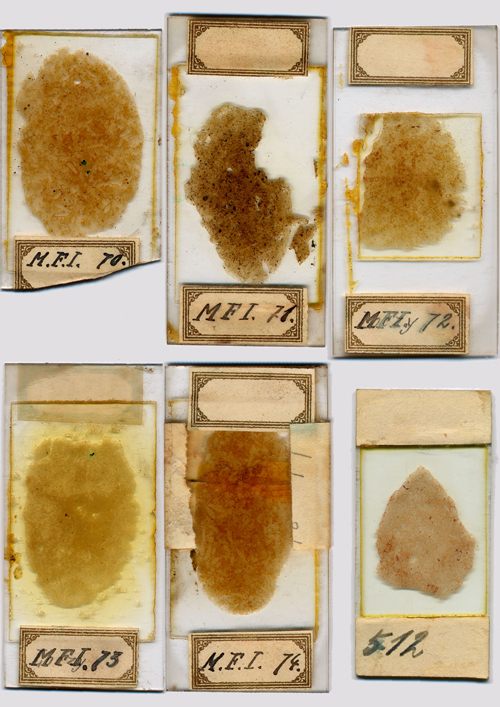
Click on thumbnail to enlarge the image.
Figure 6:
Original thin sections (6) labelled 512 and M.F.I. [*] 70 to 74 from the
Collection with Munieria baconica ,
1883. (1920) illustrated specimens from thin sections M.F.I. 70 (op.
cit.: Pl. VII, figs. 17-21 & 24-26), 72 (op.
cit.: Pl. VII, fig. 23)
and 73 (op. cit.: Pl. VII, figs. 16 & 22). Details are shown on Pls. 7 ![]() - 8
- 8 ![]() .
.
We
select the specimen first illustated by (1920) in his Pl. 7, fig. 16
(herein under Pl. 7 ![]() , fig. B) from thin section M.F.I. 73 (Sűrű-hegy,
Hungary) as the neotype of the species.
, fig. B) from thin section M.F.I. 73 (Sűrű-hegy,
Hungary) as the neotype of the species.
In
this set of thin sections (Fig. 6 ![]() ), the assemblage is almost monospecific,
largely dominated by Munieria thalli, with rare Charaxis thalli and few utricles. In their Hungarian material, et al. (2003) have
also "found together (…) Muniera thalli and the utricles of Atopochara
trivolvis ". However, there are no remains of
Dasycladales, of Foraminifera or of Echinids in the wackestone
matrices of 's Hungarian material, which suggests rather brackish
(hyposaline) water than normal sea water.
Accordingly, paleoenvironments also help us in proposing a charophyte nature and arguing against the Dasycladalean interpretation.
), the assemblage is almost monospecific,
largely dominated by Munieria thalli, with rare Charaxis thalli and few utricles. In their Hungarian material, et al. (2003) have
also "found together (…) Muniera thalli and the utricles of Atopochara
trivolvis ". However, there are no remains of
Dasycladales, of Foraminifera or of Echinids in the wackestone
matrices of 's Hungarian material, which suggests rather brackish
(hyposaline) water than normal sea water.
Accordingly, paleoenvironments also help us in proposing a charophyte nature and arguing against the Dasycladalean interpretation.
Originally described from Aptian strata in Hungary (, 1883), the species occurs at least up to the Santonian (, 1969).
Munieria parvula , 1946, n.comb.
(Pl. 2 ![]() , figs. H, I pars,
J pars, K pars & L)
, figs. H, I pars,
J pars, K pars & L)
Synonymy list (years in red indicate papers with original, previously unpublished illustrations):
1946 Clypeina parvula n.sp. [basyonym].- , p. 24-26, Fig. 1 (A-H) ["Purbeckien" = Upper Tithonian - Lower Berriasian]
1948 Clypeina parvula.- , p. 151-154, Figs. 50(1-18)-51; Pl. VI, fig. 2 ["Purbeckien"]
1955 Clypeina parvula.- , p. 52-53, Figs. 13(1-13)-14(1-9); Pl. VI, fig. 2 ["Purbeckien"]
non 1956 Clypeina parvula.- & , Pl. XIV, figs. 1(b) - 2(b)
1957 Charaxis striatus n.sp.- , p. 40, Pl. 3, figs. 10-12 [Bear River Fm, ? Cenomanian]
1958 Clypeina parvula.- , p. 187-188, Fig. 25.1-4 ["Purbeckien"]
1960 Clypeina parvula?- , Pl. XX, fig. 1; Pl. XXII, fig. 1 [Aptian-Albian]
1962 Munieria baconica.- & , p. 216 & 218, Pl. 3, figs. 19-32 ; Pl. 4 pars [Albian or Cenomanian]
non 1962 Clypeina parvula.- , Pl. VIII, fig. 12 (number "10" in caption!)
non 1962 Munieria baconica.- & , Pl. XLII (XXXII), figs. 7-8 {Salpingoporella sp.}
? 1967 Clypeina parvula.- & , p. 121, Pl. VI, figs. 8-9
1968 Munieria baconica.- & , p. 232, Pl. 6, figs. 10-13 ["passage Jurassique-Crétacé"]
? 1969 Clypeina parvula.- , p. 44
non 1969 Munieria sp.- , p. 45, Pl. 3, fig. 7
1969 Munieria baconica.- , p. 67, Pl. 49, figs. 19-32 (excerpts from & , 1962)
1969 Charaxis striatus.- , p. 84, Pl. 60, figs. 1-3 (excerpt from , 1957)
1969 "stems of Charophyta previously entitled to Dasycladacaea (Munieria baconica, Clypeina parvula)".- , p. 72-73, Fig. 4 (a-g) [Cenomanian]
non 1971 Clypeina parvula.- & , p. 422, Pl. 6, fig. 3
1971 Septorella.- & , p. 3021-3023, Pl. I, figs. 1-13 ["Bégudo-Rognacien" = Maastrichtian]
1972 Munieria baconica.- et al., Pl. CXV, figs. 1-4; Pl. 2, figs. 1-10 [Barremian-Aptian, reworked in Santonian-Campanian]
1972 Clypeina parvula.- , p. 374-378, Figs. 1(a-k)-2(a-q) ["Purbeckiano" = Upper Tithonian - Lower Berriasian]
1973 Munieria baconica.- , p. 81, Pl. 1, figs. 13-15 [Barremian]
1976 Munieria grambasti n.sp.- , p. 48-54, Pl. I, figs. 1-14; Pl. II, figs. 1-16, 18, 20-21, 24-26; Pl. IV, fig. 2 [Lower Cretaceous]
1978 Clypeina parvula.- et al., p. 52-55, Pl. 4, fig. 8 (excerpt from , 1946) - 9 (excerpt from , 1972)
1979 Munieria cf. baconica.- et al., p. 54-60, Pl. XXII, fig. 2; Pl. XXV, fig. 3 [Aptian]
1981 Munieria grambasti sarda n.ssp.- et al., p. 142-143, Fig. 2(1-4) ; Pl. 1, figs. 1-7; Pl. 2, figs. 1-10 [Cenomanian]
1982 Munieria grambasti sarda.- & , p. 268-270, Pl. I., fig. 1; Pl. II, figs. 2-3; Pl. III, figs. 4-5 [Ajka Fm = Senonian]
1983 Munieria sp. B.- & , Pl. XI, figs. 1-3 [Albian]
1983 Munieria tésense n.sp. (nomen nudum).- & , Pl. XIV, figs. 1-2 [Albian]
1984 "Clypeina parvula".- , p. 497, Pl. 14, fig. 1 ["Purbeckien"]
1989 Clypeina parvula.- & , p. 260
1991 Munieria ex gr. grambasti.- , p. 51, Pl. 1, fig. 2; Pl. 18, figs. 14-16
1992 Munieria grambasti sarda.- & , p. 23-24, Fig. 2 ; Pl. 1, figs. 1-7 [Santonian-Lower Campanian]
1994 Munieria grambasti sarda.- et al., p. 467, Pl. 2, figs. 5-6; Pl. 3 figs. 1 & 4-7 [Santonian-Campanian]
2000 Charaxis baconicus n.comb.- , p. 180-182 & 287-288, Pl. 20, figs. 4-7 [Lower Barremian]
2009 Munieria.- & , Figs. 5(a-b) & 8(f)
2009 Munieria grambasti sarda.- et al., p. 467, Fig. 5(M-O) [Santonian-Campanian]
2011 Munieria grambastii.- & , Fig. 6(C-D) [Maastrichtian]
2013 Munieria grambastii.- & , Figs. 6(c), 8(a) & 11(c) [Maastrichtian]
Clypeina parvula , 1946, was originally described from "Purbeck" facies at the Tithonian-Berriasian transition in Switzerland. The synonymy list above that includes later reports suggests that this species spans the whole Cretaceous. We found it at Homsiyeh.
& (1971) and (1972) illustrated nice specimens respectively as Septorella sp. ( & , 1971: Pl. I, figs. 1-13) and as Clypeina parvula (, 1972: Figs. 1(a-k)-2(a-q)). As a matter of fact, this species has all the main features of the genus Munieria , 1883, which justifies its transfer to this organ genus. It is very close to, though smaller (commonly half the size) than, the type-species, Munieria baconica , 1883.
Organ genus Charaxis , 1939
Original diagnosis (, 1939, p. 69): "Vegetative charophyte organs agreeing in so far as they are known with Chara. Stem consisting of nodes and internodes; internodes composed of a central cell surrounded by a ring of primary cortical cells which grow up and down from the nodes; and may cut off secondary cortical cells at their sides, primary cortical cells giving rise to spine cells; leaves as in Chara, either corticated in the same way as the stem, or uncorticated".
Type-species: Charaxis durlstonense , 1939.
Charaxis martinclosasi n.sp.
(Pl. 4 ![]() , figs. E-I;
Pl. 5
, figs. E-I;
Pl. 5 ![]() ,
figs. E & G-I; Pl. 6
,
figs. E & G-I; Pl. 6 ![]() , figs. A-F)
, figs. A-F)
Synonymy list:
1968 "fragment de tige au niveau d'un nœud ; affinités non connues".- & , p. 422, Pl. IV, fig. 12
Origin of the name: This species is dedicated to Prof. Carles (Universitat de Barcelona) for his seminal contribution to the knowledge on fossil Charophyta (see , 2000, among many other papers).
Holotype: Pl. 5 ![]() , fig. H
, fig. H
Paratypes: Pl. 4 ![]() , fig. G;
Pl. 5
, fig. G;
Pl. 5 ![]() , figs. E, G & I;
Pl. 6
, figs. E, G & I;
Pl. 6 ![]() , figs. A-F
, figs. A-F
Type-locality: 1.5 km N of Ain Dara (Mount Lebanon Governorate).
Type-level: "Grès du Liban" auct., below the "Banc de Mréjatt"
Age: Barremian, possibly Early Barremian.
Material: One thin section
(BGAD) with several random sections (Pl. 6 ![]() ,
fig. F) from the limestone bed and a
significant number of isolated tridimensional remains from the marly layer above
it.
,
fig. F) from the limestone bed and a
significant number of isolated tridimensional remains from the marly layer above
it.
Description: Remains of Charophyte thalli consisting of nodes and internodes, commonly broken in "articles" at the median part of the internodes. Individual articles look roughly like a double cone, up to 1.2 mm in length. At the level of the nodes, which are up to 0.75 mm in diameter, there are 10 pores arranged in a whorl and corresponding to 10 rather short nodal cells ("primaries") from each of which departs a dozen of grooves corresponding to cortical cells ("secondaries"). The internodes are preserved in the form of calcitic cylinders, straightened in their median part where the grooves, which up to 50 µm in width, issued respectively from their lower and upper internodes met; usually this median zone corresponds to a point of failure. The inner diameter of an internode is commonly more than half its outer diameter. The internodes are formed by one internodal cell coated by the same contiguous cortical cells ("secondaries"). In average there are 50 grooves corresponding to the impressions of cortical cells ("secondaries") per half internode.
Comparison: In the literature, we can find several examples of articles or broken pieces of thalli
with scours and grooves on the outer side. For instance,
(1972:
Fig. 2.a-l) illustrated several "articoli isolati" of "Clypeina" parvula.
However, in most
cases, the point of failure being at the node level, each article, which is
roughly cylindrical, corresponds to a single internode.
et al. (2003:
Fig. 24) refer to the genus Septorella , 1963, an hollow unbranched segment with
scours and grooves and bearing an utricle on one side. The same pattern is observed in our material with an utricle (Pl.
3 ![]() , figs.
F & H) ascribed to Clavator delteus & ,
1968, n.comb., but again its cylindrical shape and the location of the point of
failure suggest no direct relationship between this segment with an utricle
and the larger pieces of thalli discussed here.
(1963: Fig. 6) illustrated
a specimen, which he called "vegetative
part, possibly from Atopochara", that has some affinity with our
material: this article looks like a
double cone and the point of failure is located at the median part of the
internode. However, there are two or three rows of pores at the node level, as
opposed to one single row in our new species.
, figs.
F & H) ascribed to Clavator delteus & ,
1968, n.comb., but again its cylindrical shape and the location of the point of
failure suggest no direct relationship between this segment with an utricle
and the larger pieces of thalli discussed here.
(1963: Fig. 6) illustrated
a specimen, which he called "vegetative
part, possibly from Atopochara", that has some affinity with our
material: this article looks like a
double cone and the point of failure is located at the median part of the
internode. However, there are two or three rows of pores at the node level, as
opposed to one single row in our new species.
and (1968) described from the "Grès du Liban" auct. a rich Charophyta association consisting of Ascidiella reticulata & , 1968, Atopochara trivolvis var. triquetra , 1968, Clavator ampullaceus ( & , 1968) n.comb., C. delteus ( & , 1968) n.comb., Sphaerochara asema ( & , 1968) n.comb., and Charaxis martinclosasi n.sp. Based on biostratigraphic data recently acquired from the "Banc de Mréjatt", which is part of the "Grès du Liban" auct., and from the overlying Jezzinian regional stage ( et al., 2014), this charophyte assemblage is now ascribed a Barremian age (possibly Early Barremian), not a Bedoulian age as previously stated.
In the process of carrying out this investigation, material of Munieria , 1883, from the historical Collection was revised. This taxon is treated here as an organ genus belonging to the charophytes; accordingly, we follow the views of (1969), (1989), and (2000), inter alia. In our present state of knowledge, Munieria includes at least two species: the type-species, i.e., M. baconica , 1883, as well as a species that occurs in Lebanon: Clypeina parvula , 1946, that is consequently renamed here Munieria parvula , 1946, n.comb.
A part of the Lebanese material studied (SEM samples) is registered with MHNUL numbers in the collections of the Muséum d'Histoire naturelle, Université Libanaise, Fanar - El-Matn (Lebanon); another part, consisting of the thin sections, is deposited with LPB numbers in the collections the Département des Sciences de la Terre et de l'Univers, Université de Bretagne Occidentale, Brest (France).
This research is a contribution to project Nº 30959NJ - PHC CEDRE 2014, supported by of the research project of Hubert- Partnership program (PHC) CEDRE, implemented in Lebanon and France by the Ministry of Foreign Affairs (Ministère des Affaires étrangères, MAE) and the Ministry of Higher Education and Research (Ministère de l'Enseignement Supérieur et de la Recherche, MESR) led by Bruno (France) and Dany (Lebanon). This paper is also a contribution of the team project "Biodiversity: Origin, Structure, Evolution and Geology" led by Dany at the Lebanese University. The Foundation "Carnets de Géologie" has provided financial support to the first author (B.G.) for his first mission to Beirut and Lebanon in September 2013.
Thanks to a support from the SYNTHESYS Project (http://www.synthesys.info/), which is financed by European Community Research Infrastructure Action under the FP6 "Structuring the European Research Area" Programme, the first author (B.G.) got access to the historical Collection. He takes the opportunity of this publication to express his sincere appreciation to the Naturhistorisches Museum Wien - Natural History Museum Vienna (Austria), the Department of Geology and Palaeontology, Mathias (Head of Department), Andreas and their colleagues for their hospitality.
We are also grateful to Bernard who identified both the echinoderms and the orbitolinids, to Sigrid who translated the original German text on Munieria by (1883), to Phil who revised the English manuscript, and to the reviewers, Ingeborg , Carles and Pierre-Olivier , who helped to shape this contribution to the micropaleontology of Lebanon.
D. (1958).- Prilog poznavanju Jure i Krede istočnog dijela Biokova [Ein Beitrag zur Kenntnis des Jura und der Kreide des östlichen Teiles von Biokovo - Gebirge].- Geološki Vjesnik, Zagreb, Svezak 15, Broj 1, p. 161-175 (XIV Pls.).
J., A., É., M., J.M., A., D., A.C., P. & J.A. (1979). Las microfacies del Jurasico y Cretacico de las zonas externas de las Cordilleras Bébeticas.- Uuniversidad de Granada, 83 p. (XLV Pls.).
K.W. (1969).- Die obertithonische, regressive Flachwasser-Phase der Neuburger Folge in Bayern.- Bayerische Akademie der Wissenschaften, Abhandlungen, München, Mathematisch-naturwissenschaftliche Klasse, (Neue Folge), Heft 142, 174 p. (14 Pls.).
P.W. & H.S. (1971).- Calcareous algae from the Jurassic and Cretaceous of Lebanon.- Micropaleontology, New York, vol. 17, nº 4, p. 411-433.
J.-P., P., M.A., R. & M. (1978).- Les Algues Dasycladales du Jurassique et du Crétacé.- Geobios, Villeurbanne, Mémoire spécial 2, 330 p. (40 Pls.).
P. (1984).- Les formations carbonatées du Kimméridgien et du Portlandien dans le Jura méridional. Stratigraphie, micropaléontologie, sédimentologie.- Documents des Laboratoires de Géologie de Lyon, nº 91, fasc. 2, p. 445-803 (36 Pls.).
I., F., H., J. & R.F. (1994).- Die Bitumenmergel der Kainacher Gosau (Steiermark, Österreich). In: H., G. & A. (eds.), Jubiläumsschrift 20 Jahre geologische Zusammenarbeit Österreich-Ungarn, Wien, Teil 2 - A 20 éves magyar-osztrák földtani együttműködés jubileumi kötete, Bécs, rész 2.- Geologische Bundesanstalt, Wien, p. 127-144 (4 Pls.).
J. & R. (1968).- Les algues du Néocomien d'Aquitaine.- Bulletin du Centre de Recherches de Pau - SNPA, vol. 2, nº 2, p. 213-261 (7 Pls.).
J. (1976).- Munieria grambasti sp. nov. in Kalk-Geröllen der "Upohlav-Konglomerate" des mittleren Váh-Gebietes (Klippenzone, Westkarpaten).- Geologica Carpathica, Bratislava, vol. 27, nº 1, p. 45-64.
A. (1946).- Sur quelques Dasycladacées du Purbeckien du Jura.- Compte rendu des Séances de la Société de Physique et d'Histoire naturelle de Genève, vol. 63, nº 1, p. 24-26.
A. (1948).- Étude stratigraphique et micrographique du Purbeckien du Jura suisse.- Thèse Doctorat ès Sciences géologiques et minéralogiques, Université de Genève, nº 1122, 175 p. (VI Pls.).
A. (1955).- Dasycladacées du Jurassique supérieur du bassin de Genève.- Eclogae Geologicae Helvetiae, Bâle, vol. 48, nº 1, p. 31-67 (Pls. V-VI).
A. & D. (1989).- Les collections du département de géologie et des paléontologie des inverstébrés du Muséum d'Histoire naturelle de Genève. 31. la collection micropaléontologique (5ème partie).- Revue de Paléobiologie, Genève, vol. 8, nº 2, p. 259-262.
A., I., M. & R. (1981).- Lacustrine middle Cretaceous with Munieria grambasti sarda n.ssp. (Charophyta ?) of Alghero (NW Sardinia).- Revue de Micropaléontologie, Paris, vol. 23, nº 3-4, p. 138-150.
A. & R. (1999).- Montseciella, a new orbitolinid genus (Foraminiferida) from the Uppermost Hauterivian - Early Barremian of SW Europe.- Treballs del Museu de Geologia de Barcelona, vol. 8, p. 5-23.
B., J., M., du R., R., S., E., R., A., D., B., J. & M. (2007).- Dating and progradation of the Urgonian limestone from the Swiss Jura to South-East France.- Zeitschrift der Deutschen Gesellschaft für Geowissenschaften, Stuttgart, vol. 158, nº 4, p. 1025-1062.
B., M., R., J. & B. (2013).- Mapping the rise and demise of Urgonian platforms (Late Hauterivian - Early Aptian) in southeastern France and the Suisse Jura. In: P., B. & M. (eds.), Special issue: Spatial patterns of change in Aptian carbonate platforms and related events.- Cretaceous Research, vol. 39, p. 29-46.
H. & C. (2009).- Charophyte-rich microfacies in the Barremian of the Eastern Iberian Chain (Spain).- Facies, Erlangen, vol. 55, p. 387-400.
M.A., A. & R. (1974).- The genus Actinoporella in 1882, Dasycladales, green Algae. A revision.- Geologica Romana, vol. XIII, p. 1-15.
M.A. & R. (1972).- On Munieria baconica (Characeae) and Clypeina ? solkani, n.sp. (Dasycladaceae). A case of homeomorphism in calcareous green algae.- Compte rendu des Séances de la Société de Physique et d'Histoire naturelle de Genève, (nouvelle série), vol. 6, fasc. 2-3 (1971), p. 87-95 (Pls. I-II).
G. & I. (1983).- Munieriák a Magyarországi Krétában [Munieria in the Cretaceous of Hungary].- Magyar Állami Földtani Intézet Évi Jelentése, Budapest, Évről 1983, p. 167-212.
W. (1883).- Ueber einige neue Siphoneen.- Neues Jahrbuch für Mineralogie,
Geologie und Palaeontologie, Stuttgart, Jahrgang 1883, Bd. I,
p. 1-14 (Taf. I).
URL :
https://archive.org/stream/neuesjahrbuchfrm18831leon#page/n37/mode/2up
M. & R. (1962).- Un niveau à algues calcaires au passage Albien – Cénomanien en Aquitaine.- Revue de Micropaléontologie, Paris, vol. 5, nº 3, p. 214-223 (4 Pls.).
P. (1958).- Les couches de passage du Jurassique au Crétacé dans le Jura français
et sur les pourtours de la "fosse vocontienne" (Massifs subalpins
septentrionaux, Ardèche, Grands-Causses, Provence, Alpes Maritimes).- Travaux
des Laboratoires de Géologie de la Faculté des Sciences de Lyon, Paris,
vol. 3, 221 p. (6 Pls.).
URL: https://tel.archives-ouvertes.fr/tel-00814640
H. (1910).- Études sur les rudistes : rudistes de Sicile, d'Algérie, d'Égypte, du Liban et de la Perse.- Société géologique de France, Paris, (Paléontologie), Mémoire nº 41, t. XVIII, fasc. nº 1, 84 p. (7 Pls.).
O. & I.I. (1979).- Upper Aptian microfossils from the Cameniţa Valley - Sasca Română (Reşiţa - Moldova Nouă Zone, Banat - Romania).- Revue roumaine de Géologie, Géophysique et Géographie, Bucureşti, (Géologie), t. 23, nº 1, p. 111-115 (VI Pls.).
L. (1934).- Première partie. La carte géologique au millionième de la Syrie et du Liban In: Présentation d'une carte géologique générale au 1:1.000.000e de la Syrie et du Liban.- Revue de Géographie physique et de Géologie dynamique, Paris, t. VI (1933), fasc. 4, p. 269-318 (2 maps, 2 logs, Pls. XV-XXIV).
L. (1950).- Notice explicative de la Carte géologique du Liban au 200.000ème.- Ministère des Travaux Publics, Beyrouth, 74 p. (30 Pls.).
L. (1955).- Feuille géologique au 50.000e de Djezzine.- Notice explicative, Ministère des Travaux Publics, Beyrouth, 80 p. (XII Pls.).
L. (1963).- A. Liban et Syrie. Chaîne des grands massifs côtiers et confins à l'Est. In: L. (ed.), Liban, Syrie, Jordanie.- Lexique Stratigraphique International, Paris, vol. III, Asie, fasc. 10 c1, p. 7-155.
L. & H. (1937).- Révision de la stratigraphie du Crétacé du Liban. In: L. (ed.), Contributions à l'étude géologique de la côte libano-syrienne.- Haut-Commissariat de la République Française en Syrie et au Liban, Notes et Mémoires, Paris, (Section d'études géologiques), tome II, p. 43-85.
P. (1958).- Contribution à la connaissance du Crétacé basal au Liban.- Revue de Micropaléontologie, Paris, vol. 1, nº 24, p. 87-115.
G.F. (1958a).- Algal debris-facies in the Cretaceous of the Middle East.- Paleontology, London, vol. I, part 3, p. 254-259 (Pls. 45-48).
G.F. (1958b).- Fossil microproblematica from the Middle East.- Micropaleontology, New York, vol. 4, nº 4, p. 419-428 (3 Pls.).
G.F. (1968).- Permian to Palaeocene calcareous Algae (Dasycladaceae) of the Middle East.- Bulletin of the British Museum (Natural History), Geological (Palaeontological) series, London, Supplement 4, 111 p. (24 Pls.).
S. & H. (1971).- Précisions paléontologiques sur les algues Munieria et Septorella .- Comptes Rendus hebdomadaires des Séances de l'Académie des Sciences, Paris, (série D), t. 272, nº 24, p. 3021-3023 (Pl. I).
M., P. & N. (2003).- Ancient Dasycladales and Charophyta: convergences and differences, with special attention to Munieria baconica.- Phycologia, Lawrence, vol. 42, nº 2, p. 123-132.
M., N., M., K., H.-N., R.M., Q.-F. & S.-Z. (2005).- Part B - Protoctista 1. Volume 1: Charophyta.- Treatise on Invertebrate Paleontology, the Geological Society of America, Boulder, and the University of Kansas, Lawrence, 170 p.
I. & I. (2013).- Fossils of the Carpathian region.- Indiana University Press, Bloomington, 508 p.
O. (1878).- Aus dem Orient: Geologische Beobachtungen am Libanon.- Schweizerbart, Stuttgart, 278 p.
M. (1978).- El Jurásico terminal y el Cretácico inferior de las Sierras de Cazorla y del Segura (Zona Prebética).- Tesis doctorales de la Universidad de Granada, 190, 344 p. (XXXV Pls.).
M. & K. (1982).- Munierák a Sümeg-Gyepükaján környéki szenonból (ajkai formáció).- Földtani közlöny, Budapest, köt. 112, sz. 3, p. 267-274.
L. (1963).- Classification de l'Embranchement des Charophytes.- Naturalia monspeliensia, (sér. Bot.), fasc. 14 (1962), p. 63-87-56.
L. & J. (1968).- Une flore de Charophytes du Crétacé inférieur du Proche-Orient.- Naturalia monspeliensia, (sér. Bot.), fasc. 19, p. 47-56 (Pls. I-IV).B. (1987).- Le Crétacé inférieur de la Costa Blanca entre Busot et Altea, Alicante (Espagne) : biostratigraphie, sédimentologie, évolution tectono-sédimentaire.- Thèse, Docteur de l'Université Paris VI (nouveau régime), 23 Novembre 1987 ; Mémoires des Sciences de la Terre, Université Pierre et Marie Curie, Paris, 87-49, vol. I (texte): 281 p. ; vol. II (planches): 54 Pls.
B. (1988).- Algues Chlorophyceae du Jurassique terminal et du Crétacé inférieur en Alicante.- Mediterranea, Alicante, nº 5 (1986), p. 5-96 (12 Pls.).
B. (2012).- The contribution of calcareous green algae to the production of limestones: a review. In : D. & B. (eds.), Calcareous algae and the global change: from identification to quantification.- Geodiversitas, Paris, vol. 34, nº 1, p. 35-60.
B., R., B., M., J., G. & P. (2014).- Refurbishing the Urgonian biostratigraphy: A key section at L'Estellon, Drôme, France. In: R., J., J.C. & S. (eds.), STRATI2013. First International Congress on Stratigraphy at the cutting edge of stratigraphy.- Springer, Heidelberg, p. 1095-1097.
B., B., M., R., J., G. & P. (2013).- L'Estellon (Baronnies, France), a "Rosetta Stone" for the Urgonian biostratigraphy.- Carnets Geol., Madrid, vol. 13, nº A04 (CG2013_A04), p. 163-207.
B. & R. (1993).- Inventaire des algues Dasycladales fossiles. IIe partie- Les Algues Dasycladales du Jurassique et du Crétacé.- Revue de Paléobiologie, Genève, vol. 12, nº 1, p. 19-65.
T.M. (1939).- British Purbeck Charophyta.- British Museum (Natural History), London, 83 p. (17 Pls.).
F. (1942).- La géologie d'une partie du Liban Sud.- Thesis, Dr in de Wis- en Natuurkunde aan de Rijksuniversiteit Groningen; Leidsche Geologische Meddedeelingen, vol. XII, fasc. 2, p. 251-470.
M. (1973).- Les algues calcaires du Jurassique supérieur et du Crétacé inférieur des Corbières. Première partie.- Revue de Micropaléontologie, Paris, vol. 16, nº 2, p. 75-88.
J.H. (1961).- Limestone-building algae and algal stromatolites.- Colorado School of Mines, Golden, 297 p. (139 Pls.).
J.H. (1969).- A review of the Lower Cretaceous algae.- Professional Contributions of the Colorado School of Mines, Golden, nº 6, 180 p. (68 Pls.).
S., B., D., R., J.-C. & J.A. (2014).- Revision of "Falaise de Blanche" (Lower Cretaceous) in Lebanon, with the definition of a Jezzinian Regional Stage.- Carnets Geol., Madrid, vol. 14, nº 18, p. 401-427.
C. (1996).- A phylogenetic system of Clavatoraceae (fossil Charophyta).- Review of Palaeobotany and Palynology, vol. 94, nº 3-4, p. 259-293.
C. (2000).- Els caròfits del Juràssic superior i Cretaci inferior de la Península Ibèrica.- Arxius de les Seccions de Ciències, Institut d'Estudis Catalans, 125, 304 p.
J., F.R., W.R., V., W.,
D.L., P.S., S.,
K., J., van W.F., G.F.,
J.H. & N.J. (2012).- International
Code of Nomenclature for algae, fungi, and plants (Melbourne Code). Regnum
Vegetabile 154.- Koeltz Scientific Books, Koenigstein, xxx + 240 p.
URL: http://www.iapt-taxon.org/nomen/main.php?page=title
L. & B. (1967).- Fosilne Dasycladaceae gornje jure Velebita i sjeverozapadne Velike Kapele [Fossil Dasycladaceae from Upper Jurassic of the Mount Velebit and the NW part of the mount Velika Kapela]. – Rad Jugoslavenska Akademija Znanosti i Umjetnosti, Zagreb, Knjiga 345, p. 101-134 (VIII Pls.).
R.E. (1957).- North American Mesozoic Charophyta.- Shorter Contributions to General Geology 1956, Geological Survey Professional Paper, Washington, 294, 44 p. (8 Pls.).
G. (1972).- Microflora "purbeckiana" della Nurra (Sardegna).- Bolletino della Società Geologica Italiana, Roma, vol. 91, p. 373-385.
J. von (1920).- Die Siphoneae verticillatae vom Karbon bis zur Kreide.- Abhandlungen
der zoologisch-botanischen Gesellschaft in Wien, Band XI, Heft 2, 263 p.
(VIII Pls.).
URL: https://archive.org/details/diesiphoneaevert00piaj
J. von (1927).- 1. Abteilung: Thallophyta. In: M. (ed.), Handbuch der Paläobotanik.- Oldenbourg, München & Berlin, Band I: Thallophyta - Bryophyta - Pteridophyta, p. 31-136.
J. von (1961).- Les Siphonées verticillées du Carbonifère au Crétacé.- Éditions Technip, Rueil-Malmaison, 258 p. (8 Pls.).
R., M., J.-P. & M. (2009).- A new phytal limnic ostracod Rosacythere carpathica sp. nov. from the Upper Cretaceous of the Western Carpathians: implications for evolution of the Timiriaseviinae.- Cretaceous Research, vol. 30, p. 465-476.
A. (1969).- Les algues du toit des bauxites des environs de Mazaugues (Var).- Revue de Micropaléontologie, Paris, vol. 11, nº 4, p. 233-240.
R. (1958).- Munieria baconica u donje krednim slojevima okoline Titograda [Munieria baconica dans les couches du Crétacé inférieur aux environs de Titograd].- Vesnik Zavoda za Geološka i Geofizička Istraživanja NR Srbije, Beograd, t. XVI, p. 79-86 (Pl. I).
R. (1960).- Mikrofacije Krede i starijeg Tercijara spoljašnjih Dinarida jugoslavije [Microfaciès du Crétacé et du Paléogène des Dinarides externes de Yougoslavie].- Paléontologie des Dinarides yougoslaves, Titograd, (Série A : Micropaléontologie), t. IV, Livre 1, 172 p. (LVIII Pls.).
R. (1969).- A new Lower Cretaceous Dasycladacea, Clypeina pejovici, and note on some Clypeinae.- Geologica Romana, vol. 8, p. 71-84.
R. & B.B. (1956).- Beleška o nalasku krečnjačkih algi u mezozojskim naslagama Crne Gore [Mitteilung über den Funde von Kalkalgen in den mesozoischen Ablagerungen in Crna Gora (Montenegro)].- Geološki Glasnik [Bulletin géologique], Cetinje, Livre 1, p. 233-238 (Pls. XII-XIV).
P. (1970).- Contribution à la connaissance du Crétacé basal au Liban.- Revue de Micropaléontologie, Paris, vol. 12, nº 4, p. 224-233.
O., K. & E. (1972).- Microfauna and lithostratigraphy of the Paleogene and adjacent Cretaceous of the Middle Váh Valley (West Carpathian).- Geologický ústav Dionýza Štúra, Bratislava, 246 p. (CLXXX Pls.).
S. & U. (1962).- Ricerche biostratigrafiche nel Mesozoico dell'Appennino meridionale.- Giornale di Geologia, Bologna, vol. XXIX, (serie 2a), p. 161-302 (Pls. XI-LII).
F. (1991).- Allochthone Urgonkalke im Mittleren Abschnitt der Nördlichen Kalkalpen: Fazies, Paläontologie und Paläogeographie.- Münchner Geowissenschaftliche Abhandlungen, Reihe A, Geologie und Paläontologie, 20, 119 p. (19 Pls.).
F. & M. (1992).- Über ein Vorkommen von Munieria grambasti sarda et al. in der Gosau Gruppe des Miesenbachtales (Niederösterreich).- Mitteilungen der Gesellschaft der Geologie- und Bergbaustudenten in Österreich, Wien, vol. 38, p. 21-29 (Pl. 1).
M. (1989).- Charophytenfloren aus den unterkretazischen Vertebraten-Fundschichten bei Galve und Uña (Ostspanien). - Berliner Geowissentschaftlche Abhandlungen (A), 106, p. 409-443.
M. (1990).- Bestandsaufnahme und Lokalzonierung der Charophyten aus Oberjura und Unterkreide des Nordwestdeutschen Beckens.- Berliner Geowissentschaftlche Abhandlungen (A), 124, p. 209-245.
R., F.S.P. van, A., D., B., A. & B. (2010).- Revised orbitolinid biostratigraphic zonation for the Barremian - Aptian of the eastern Arabian Plate and implications for regional stratigraphic correlations.- GeoArabia, Manama, vol. 1, p. 49-96.
G. (1963).- Aptian Charophyta of southern Latium.- Geologica romana, vol. II, p. 279-290.
M.C. (1913).- Catalogue of the Mesozoic plants of the Department of Geology, British Museum, Natural History. Part V.- Taylor & Francis, London, 285 p. (II Pls.).
B. (1965, unpublished).- Contribution à l'étude des grès de base du Liban.- Thèse 3º cycle, Université de Paris, Centre d'Orsay, 89 p. (29 Pls.).
B. (1972).- Le "grès de base" crétacé du Liban : étude stratigraphique et sédimentologique.- Notes et Mémoires sur le Moyen-Orient, Paris, tome XII, p. 187-215.
S. (2012).- Els caròfits de les fàcies continentals i transicionals del Garumnià basal (Cretaci superior) del Pirineu Oriental.- PhD Thesis, Universitat de Barcelona, p. 319-345.
S. & C. (2011).- A characean thallus with attached gyrogonites and associated fossil charophytes from the Maastrichtian of the Eastern Pyrenees (Catalonia, Spain).- Journal of Phycology, vol. 47, nº 1, p. 131-143.
S. & C. (2013).- Upper Cretaceous paleogeography of the Central Southern Pyrenean Basins (Catalonia, Spain) from microfacies analysis and charophyte biostratigraphy.- Facies, vol. 59, p. 319-345.
G. (1926).- Géologie du Liban.- Henry Barrère, Paris, 165 p.
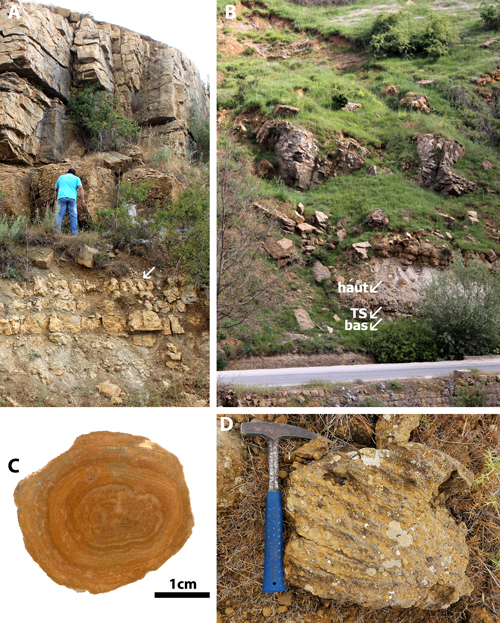
Click on thumbnail to enlarge the image.
A) Falougha section (behind the water bottling plant) with the "Banc de Mréjatt" of (1942). The arrow points to the marly sample for Charophyta above lacustrine limestones; B) Ain Dara section with the "Banc de Mréjatt" of (1942). The arrow labelled "TS" points to the limestone sample (thin section BGAD) and the arrows "bas" and "haut" point to the marly samples; C) Polished slab of a loose pisolite from Homsiyeh; D) Cross-bedded calcirudites with pisolites, near Falougha (N 33°50'38.781", E 35°45'6.604", alt. 1484m).
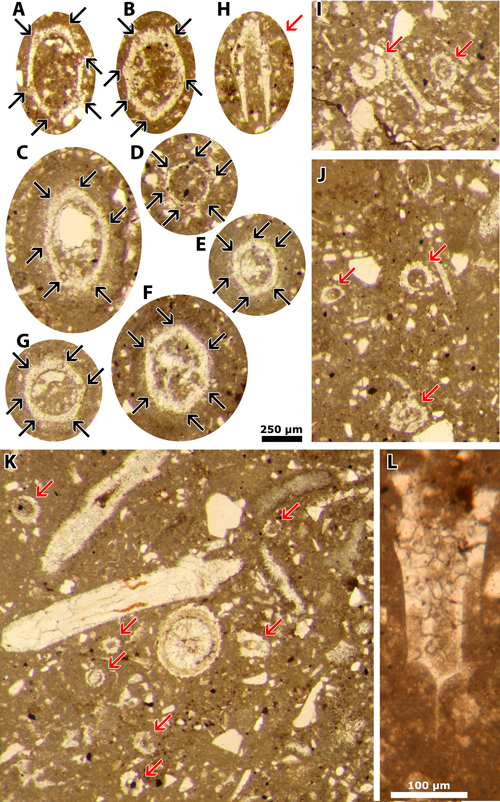
Click on thumbnail to enlarge the image.
Plate 2: (Homsiyeh)
A-G) sections of utricles with the location (black arrows) of the 6 pores corresponding to the 6 spine-shaped bracts of the external utricular layer; H-K) sections of thalli of Munieria (red arrows); K) toward the center of the photomicrograph, an utricle with its gyrogonite; L) tangential section. The zigzag pattern corresponds to the median part of an internode where the grooves (i.e., the contiguous cortical cells) issued respectively from its lower and upper internodes met. All photomicrographs have the same magnification, except L.
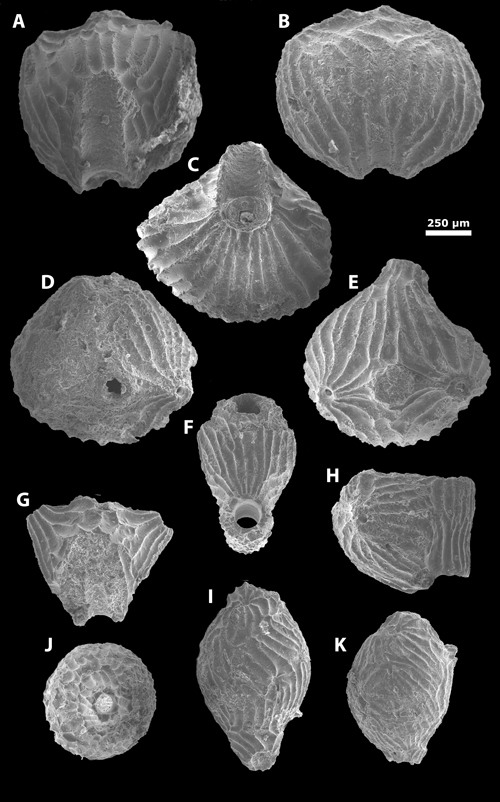
Click on thumbnail to enlarge the image.
Plate 3: (Homsiyeh)
Clavator ampullaceus ( & , 1968) , 1996 [formerly Lucernella ampullacea & , 1968]
A) ventral face, anterior view (showing one impression of a phylloid); B) dorsal face, posterior view; C) basal view (showing one impression of a phylloid); D-E) apical views.
Clavator delteus ( & , 1968) n.comb. , & [formerly Lucernella deltea & , 1968]
F) apical view (showing a fragment of a phylloid). et al. (2003: Fig. 24) refer a similar specimen, i.e., an utricle fixed to a hollow unbranched thallus, to the genus Septorella , 1963; G) ventral face, anterior view; H) lateral view (showing a fragment of a phylloid). See above comment in F.
Ascidiella reticulata & , 1968
I) lateral view; J) apical view; K) lateral view.
All photomicrographs have the same magnification.
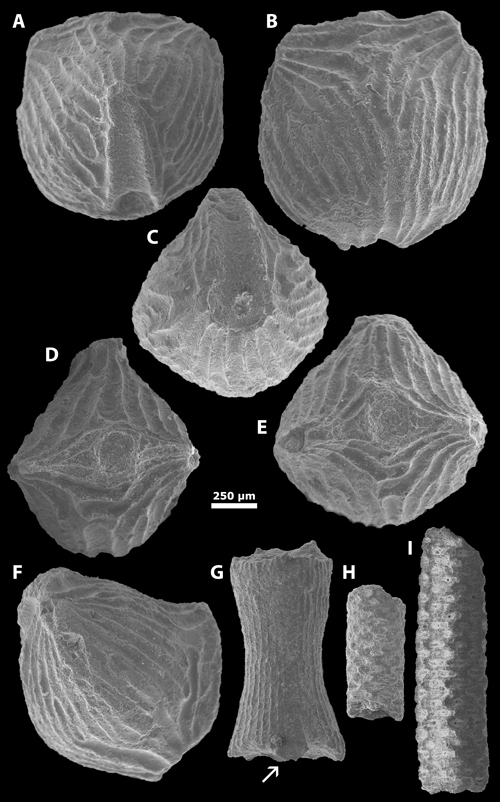
Click on thumbnail to enlarge the image.
Plate 4: (Ain Dara and Homsiyeh)
Clavator ampullaceus ( & , 1968) , 1996 [formerly Lucernella ampullacea & , 1968] (loc.: Ain Dara)
A) ventral face, anterior view (showing one impression of a phylloid); B) dorsal face, posterior view; C) basal view (showing one impression of a phylloid); D-E) apical views; F) lateral view.
Charaxis martinclosasi n.sp. (loc.: Ain Dara)
G) internode showing the impression of a phylloid above the node (arrow).
Salpingoporella (Hensonella) dinarica (, 1959) (loc.: Homsiyeh)
H-I) thalli.
All photomicrographs have the same magnification.
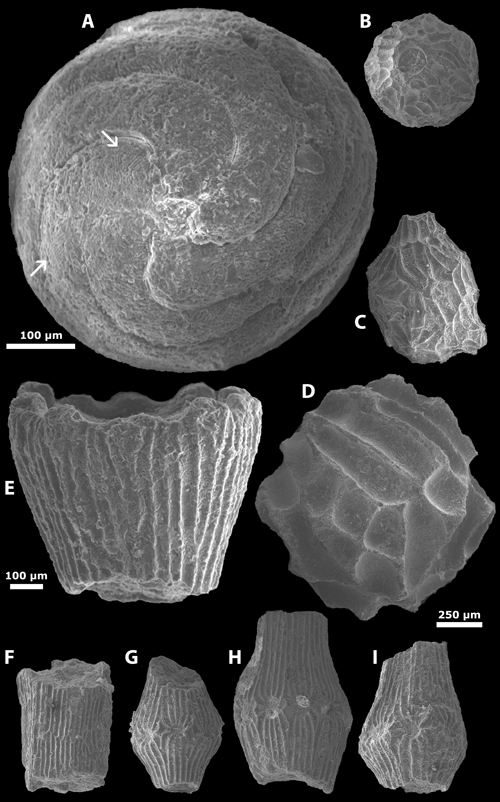
Click on thumbnail to enlarge the image.
Plate 5: (Ain Dara and Falougha)
Sphaerochara asema ( & , 1968) n.comb. , & [formerly Peckisphaera asema & , 1968] (loc.: Falougha)
A) apical view of a gyrogonite, see the calcification pattern (arrows).
Ascidiella reticulata & , 1968 (loc.: Falougha)
B) apical view; C) lateral view.
Atopochara trivolvis var. triquetra , 1968 (loc.: Ain Dara)
D) lateral view.
Charaxis martinclosasi n.sp. (loc.: Ain Dara)
E) half internode; G-I) two halves of intenodes, with the verticillate node in medial position (H is the holotype).
Charaxis sp. (loc.: Ain Dara)
F) part of an internode showing interdigitations of cortical cells issued from both the upper and the lower nodes.
All photomicrographs have the same magnification, except A and E.
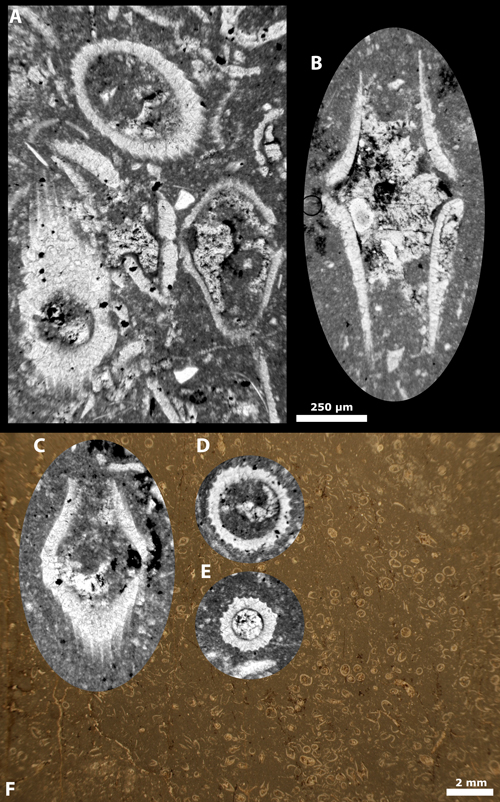
Click on thumbnail to enlarge the image.
Plate 6: (Ain Dara). Thin section (BGAD)
Charaxis martinclosasi n.sp.
A) various oblique sections of articles; B) a subaxial section of an article with the node at its median part; C) an oblique section with the node at its median part. In the lower part, scours and grooves corresponding to the cortical cells ("secondaries") can be seen on the internode; D-E) transverse section at an internode level; F) the microfacies is a wackestone of Charophyta articles.
All photomicrographs have the same magnification, except F.
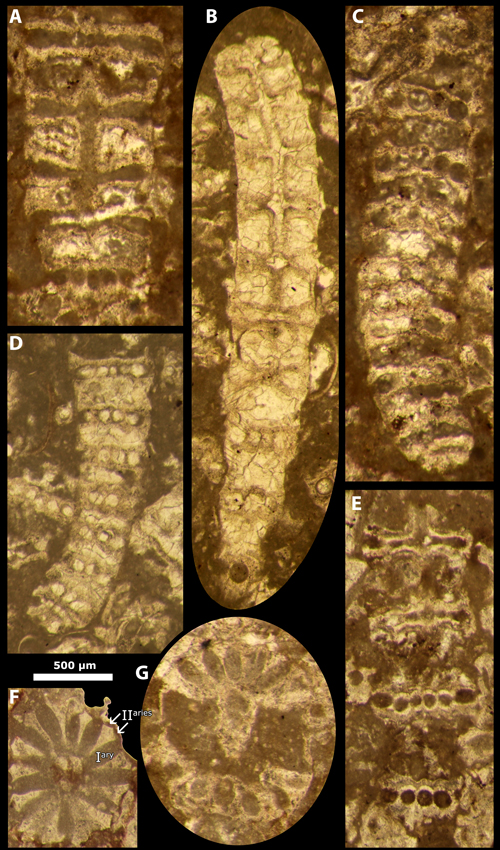
Click on thumbnail to enlarge the image.
Plate 7: Munieria baconica , 1883 (, 1920)
A)
, 1920: Pl. 7, fig. 19 – Thin section M.F.I. 70, not Kerteshegy fide
(1920), but probably "Penzeskut" = Pénzesgyőr (Hungary);
B)
, 1920: Pl. 7, fig. 16 - Thin section M.F.I. 73, Sűrű-hegy
(Hungary) fide (1920);
C)
, 1920: Pl. 7, fig. 17 – Thin section M.F.I. 70, Pénzesgyőr
(Hungary) fide (1920);
D)
, 1920: Pl. 7, fig. 22 – Thin section M.F.I. 73, Sűrű-hegy
(Hungary) fide (1920);
E)
, 1920: Pl. 7, fig. 23 – Thin section M.F.I. 72, Tündérmajor
(Hungary) fide (1920);
F)
a whorl made of 12 nodal cells
("primaries"). Arrows point to grooves corresponding to the proximal part of the cortical cells;
("secondaries"). Compare with Pl. 1, fig. 5 (herein Fig. 5.5 ![]() ) in
(1883) – Thin section 512; G)
, 1920: Pl. 7, fig. 25 – Thin section M.F.I. 70, Penzeskut (Hungary)
fide (1920). All
photomicrographs have the same magnification.
) in
(1883) – Thin section 512; G)
, 1920: Pl. 7, fig. 25 – Thin section M.F.I. 70, Penzeskut (Hungary)
fide (1920). All
photomicrographs have the same magnification.
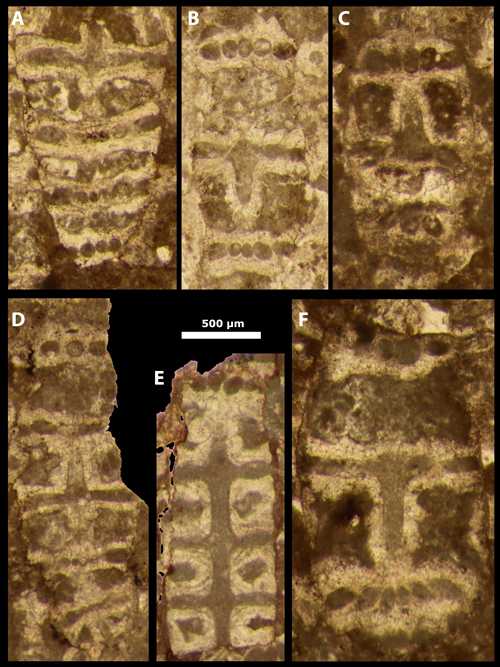
Click on thumbnail to enlarge the image.
Plate 8: Munieria baconica , 1883 (, 1920)
A)
, 1920: Pl. 7, fig. 20 – Thin section M.F.I. 70, Pénzesgyőr
(Hungary) fide (1920);
B)
, 1920: Pl. 7, fig. 21 - Thin section M.F.I. 70, Pénzesgyőr
(Hungary) fide (1920);
C)
, 1920: Pl. 7, fig. 26 – Thin section M.F.I. 70, Pénzesgyőr
(Hungary) fide (1920);
D)
, 1920: Pl. 7, fig. 24 – Thin section M.F.I. 70, Pénzesgyőr
(Hungary) fide (1920);
E)
, 1920: Pl. 7, fig. 18 – Thin section M.F.I. 70, Pénzesgyőr
(Hungary) fide (1920);
F) Compare with Pl. 1, fig. 6 (herein Fig.
5.6 ![]() ) in (1883) – Thin section
512. All
photomicrographs have the same magnification.
) in (1883) – Thin section
512. All
photomicrographs have the same magnification.
It is not a Total Range Zone.
The basyonim is Peckisphaera asema
& , 1968, Nat. Monspeliensia (Ser. Bot.), 19: 52-53, Pl. III, figs. 7 (holotype C-705-6) & 8-12.
The type-species of the genus Peckisphaera
, 1963, is Sphaerochara verticillata (, 1937) 1957.
However, (2000)
restored this species to the original genus. Consequently, Peckisphaera , 1963, should be treated as a junior synonym of Sphaerochara, 1952. However, (2000)
was not explicit on the status of the remaining species. Accordingly, we (B.G.,
D.A. & S.M.) agreed to transfer the species Peckisphaera
asema & , 1968, to the genus Sphaerochara, 1952.
The extracellular calcification of fossil Dasycladales was mostly aragonitic and rarely consisted of yellowish calcite as,,for instance, in Salpingoporella (Hensonella) dinarica (, 1959) or in Salpingoporella urladanasi et al., 1977 (see , 2012). In contrast, the calcification of vegetative remains of charophytes can be partly to magnesium calcite and partly to aragonite (, personal communication).
There are two discrete batches in the referenced collection, one with Roman numerals and the other with Arabic numerals.
M.F.I. possibly stands for the Magyar Földtani Intézet.